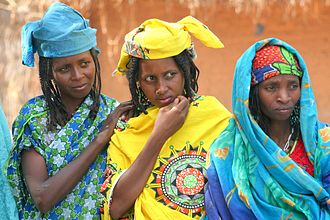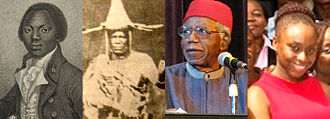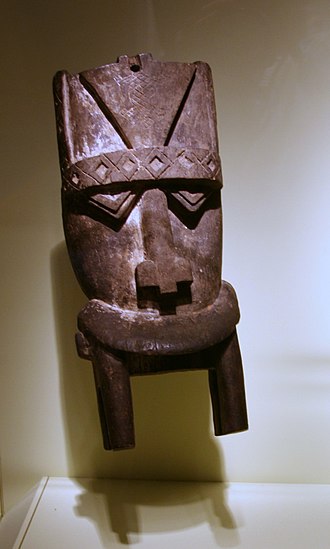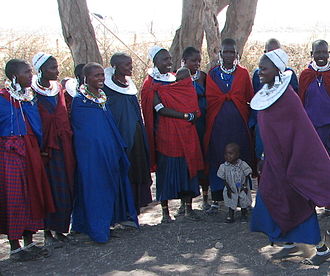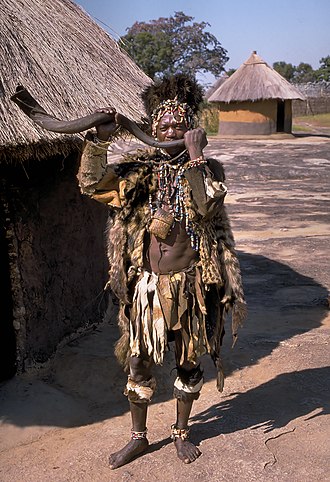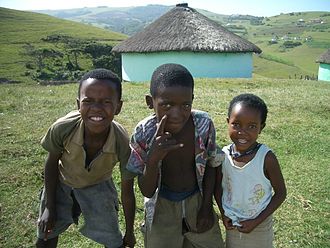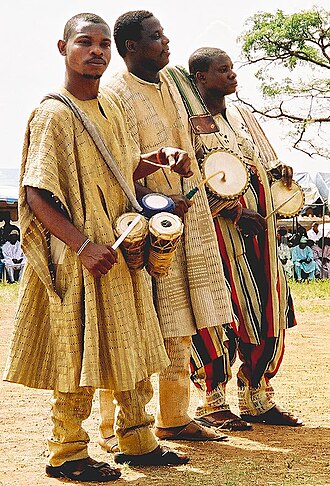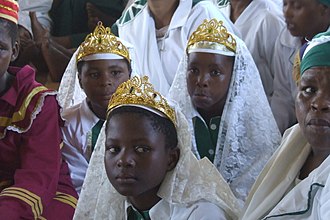Especialidades JA/Tradición africana/Respuestas
1. Be able to name and locate at least ten different African tribes of the present day and name several outstanding features of each.
The answers for requirement two include information about the location of the tribes described. We suggest that you consult a map of Africa and using the information presented below, locate the areas where ten tribes are today. Requirement two also provides many outstanding features of the tribes described.
2. Hacer lo siguiente:
a. Seleccionar una tribu africana para el estudio. Si usted pertenece a una tribu africana, seleccionar una que no sea la suya.
b. Encontrar información detallada sobre las tribus seleccionadas, en las siguientes áreas:
i. Los hábitos alimenticios
ii. Ceremonia de iniciación
iii. Médicos tradicionales y yerbateros
iv. Condiciones de vida y cultos
v. Educación��
=vi. Entierros
vii. Dinero
iix. Vestido
ix. Industria
|Dress=The Amhara live at high altitudes (2100-4200 meters![]() ), so their clothing is designed to be warm. In modern times, the Amhara dress in western clothing manufactured in Asia. Some still prefer traditional clothing, which consists of jodphurs and a shirt, with an outer garment called a gabi.
), so their clothing is designed to be warm. In modern times, the Amhara dress in western clothing manufactured in Asia. Some still prefer traditional clothing, which consists of jodphurs and a shirt, with an outer garment called a gabi.
|Industry=Most people are employed in agricultural pursuits, but many also run businesses, trading all sorts of goods.
|Location=Ethiopia
|Members=19.8 million }}
Fula
| Fula |
|---|
|
Hábitos alimenticios: Dairy is an important part of the diet, including milk, yogurt, and butter. Their main meal of the day will feature a porridge made from grain (millet, sorghum, or corn). Educación: Children are educated by their parents and by older siblings. They also attend Koranic schools where they learn the scriptures and teachings of Islam. Vestimenta: The traditional dress of the Fula in most places consists of long colorful flowing robes, modestly embroidered or otherwise decorated. |
Igbo
| Igbo |
|---|
|
Hábitos alimenticios: The yam is very important to the Igbo as it is their staple crop. There are celebrations such as the New yam festival which are held for the harvesting of the yam. During the festival yam is eaten throughout the communities as celebration. Yam tubers are shown off by individuals as a sign of success and wealth. Rice has replaced yam for ceremonial occasions. Other foods include cassava, garri, maize and plantains. Soups or stews are included in a typical meal, prepared with a vegetable (such as okra, of which the word derives from the Igbo language, Okwuru) to which pieces of fish, chicken, beef, or goat meat are added. Jollof rice is popular throughout West Africa. The Igbo believe in reincarnation. People are believed to reincarnate into families that they were part of while alive. Before a relative dies, it is said that the soon to be deceased relative sometimes give clues of who they will reincarnate as in the family. Once a child is born, he or she is believed to give signs of who they have reincarnated from. This can be through behavior, physical traits and statements by the child. A diviner can help in detecting who the child has reincarnated from. Dinero: File:Stamp Nigeria 1953 0.5p manilla.jpg A Stamp depicting Manillas Manillas are ring-like armlets, mostly in bronze or copper, very rarely gold, which served as a form of money or barter coinage and to a degree, ornamentation, amongst certain West African peoples including the Igbo. They also became known as "slave trade money" after the Europeans started using them to acquire slaves for the slave trade into the Americas (as well as England prior to 1807). Women traditionally carry their babies on their backs with a strip of clothing binding the two with a knot at her chest, a practice used by many ethnic groups across Africa. This method has been modernized in the form of the child carrier. In most cases Igbo women did not cover their breast areas. Maidens usually wore a short wrapper with beads around their waist and other ornaments such as necklaces and beads. Both men and women wore wrappers. Men would wear loin cloths that wrapped round their waist and between their legs to be fastened at their back, the type of clothing appropriate for the intense heat as well as jobs such as farming. In the same era as the rise of colonial forces in Nigeria, the way the Igbo dressed changed. These changes made the Igbo adopt Westernized clothing such as shirts and trousers. Clothing worn before colonialism became "traditional" and worn on special occasions. The traditional clothing itself became westernized with the introduction of various types of Western clothing including shoes, hats, trousers, etc. Modern Igbo traditional attire, for men, is generally made up of the Isiagu top which resembles the Dashiki worn by other African groups. Isiagu (or Ishi agu) is usually patterned with lions heads embroidered over the clothing and can be a plain color. It is worn with trousers and can be worn with either a traditional title holders hat or with the traditional Igbo stripped men's hat. For women, a puffed sleeve blouse (influenced by European attire) along with two wrappers and a head tie are worn. Miembros: Between 24 and 25 million |
Ijaw
| Ijaw |
|---|
|
Hábitos alimenticios: Like many ethnic groups in Nigeria, the Ijaws have many local foods that are not widespread in Nigeria. Many of these foods involve fish and other seafoods such as clams, oysters and periwinkles; yams and plantains. Some of these foods are:
|
Maasai
Shona
| Shona |
|---|
|
Hábitos alimenticios: The majority of Zimbabweans depend on a few staple foods. Meat, beef and to a lesser extent chicken are especially popular, though consumption has declined under the Mugabe regime due to falling incomes. "Mealie meal" (cornmeal) is used to prepare sadza or isitshwala and bota or ilambazi. Sadza is a porridge made by mixing the cornmeal with water to produce a thick paste. After the paste has been cooking for several minutes, more cornmeal is added to thicken the paste. This is eaten as lunch and dinner, usually with greens (such as spinach, chomolia, collard greens), beans and meat that has been stewed, grilled, or roasted. Sadza is also commonly eaten with curdled milk, commonly known as lacto (mukaka wakakora), or dried Tanganyika sardine, known locally as kapenta or matemba. Bota is a thinner porridge, cooked without the additional cornmeal and usually flavoured with peanut butter, milk, butter, or, sometimes, jam. Bota is usually eaten for breakfast. The wealthier portion of the population usually send their children to independent schools as opposed to the government-run schools which are attended by the majority as these are subsidised by the government. School education was made free in 1980, but since 1988, the government has steadily increased the charges attached to school enrollment until they now greatly exceed the real value of fees in 1980. The Ministry of Education of Zimbabwe maintains and operates the government schools but the fees charged by independent schools are regulated by the cabinet of Zimbabwe. Zimbabwe's education system consists of 7 years of primary and 6 years of secondary schooling before students can enter university in the country or abroad. The academic year in Zimbabwe runs from January to December, with three month terms, broken up by one month holidays, with a total of 40 weeks of school per year. National examinations are written during the third term in November, with "O" level and "A" level subjects also offered in June. If a person initiates the burial of a person of a different totem, he runs the risk of being asked to pay a fine to the family of the deceased. Such fines traditionally were paid with cattle or goats but nowadays substantial amounts of money can be asked for. Inflation rose from an annual rate of 32% in 1998 to an IMF estimate of 150,000% in December 2007, and to an official estimated high of 231,000,000% in July 2008 according to the country's Central Statistical Office. This represented a state of hyperinflation, and the central bank introduced a new 100 billion dollar note. As of November 2008, unofficial figures put Zimbabwe's annual inflation rate at 516 quintillion per cent, with prices doubling every 1.3 days. Zimbabwe's inflation crisis is now (2009) the second worst inflation spike in history, behind the hyperinflationary crisis of Hungary in 1946, in which prices doubled every 15.6 hours. By 2005, the purchasing power of the average Zimbabwean had dropped to the same levels in real terms as 1953. Local residents have largely resorted to buying essentials from neighbouring Botswana, South Africa and Zambia. |
Tuareg
| Tuareg |
|---|
|
Hábitos alimenticios: The Tuareg diet consists mostly of grains supplemented with fruits such as dates and melons (when in season), and milk and cheese. Meat is reserved for special occasions.
Religión: The Tuareg are predominantly Muslim and generally follow the Maliki madhhab, one of the four schools of Fiqh or religious law within Sunni Islam. |
Xhosa
| Xhosa |
|---|
|
Hábitos alimenticios: The Xhosa settled on mountain slopes of the Amatola and the Winterberg Mountains. Many streams drain into great rivers of this Xhosa territory including the Kei and Fish Rivers. Rich soils and plentiful rainfall make the river basins good for farming and grazing making cattle important and the basis of wealth. Traditional foods include beef (Inyama yenkomo), mutton (Inyama yegusha), and goat meat, sorghum, maize and dry maize porridge (umphokoqo), "umngqusho" (made from dried, stamped corn and dried beans), milk (often fermented, called amasi), pumpkins (amathanga), beans (iimbotyi), and vegetables. The Xhosas have a strong oral tradition with many stories of ancestral heroes; according to tradition, the leader from whose name the Xhosa people take their name was the first human on Earth. Other traditions have it that all Xhosas are descended from one ancestor named Tshawe. The key figure in the Xhosa oral tradition is the imbongi (plural: iimbongi) or praise singer. Iimbongi traditionally live close to the chief's "great place" (the cultural and political focus of his activity); they accompany the chief on important occasions - the imbongi Zolani Mkiva preceded Nelson Mandela at his Presidential inauguration in 1994. Iimbongis' poetry, called imibongo, praises the actions and adventures of chiefs and ancestors. Christian missionaries established outposts among the Xhosa in the 1820s, and the first Bible translation was in the mid-1850s, partially done by Henry Hare Dugmore. Xhosa did not convert in great numbers until the 1900s, but now many are Christian, particularly within the African Initiated Churches such as the Zion Christian Church. Some denominations combine Christianity with traditional beliefs. |
Yoruba
| Yoruba |
|---|
|
The popularly known Vodou religion of Haiti combines the religious beliefs of the many different African ethnic nationalities taken to the island with the structure and liturgy from the Fon-Ewe of present-day Benin and the Congo-Angolan culture area, but Yoruba-derived religious ideology and deities also play an important role. Yoruba deities include "Ọya" (wind/storm), "Ifá" (divination or fate), "Ẹlẹda" (destiny), Orisha or Orisa "Ibeji" (twin), "Ọsanyin" (medicines and healing) and "Ọsun" (goddess of fertility, protector of children and mothers), Sango (God of thunder). Human beings and other sentient creatures are also assumed to have their own individual deity of destiny, called "Ori", who is venerated through a sculpture symbolically decorated with cowrie shells. Traditionally, dead parents and other ancestors are also believed to possess powers of protection over their descendants. This belief is expressed in veneration and sacrifice on the grave or symbol of the ancestor, or as a community in the observance of the Egungun festival where the ancestors are represented as a colorful masquerade of costumed and masked men who represent the ancestral spirits. Dead parents and ancestors are also commonly venerated by pouring libations to the earth and the breaking of kolanuts in their honor at special occasions. Today, many contemporary Yoruba are active Christians (60%) and Muslims (30%), yet retain many of the moral and cultural concepts of their traditional faith.
Ubicación: Nigeria, Benin, and Togo |
Zulu
| Zulu |
|---|
|
Hábitos alimenticios: In the precolonial period, indigenous cuisine was characterized by the use of a very wide range of fruits, nuts, bulbs, leaves and other products gathered from wild plants and by the hunting of wild game. The domestication of cattle in the region about two thousand years ago by Khoisan groups enabled the use of milk products and the availability of fresh meat on demand. However, during the colonial period the seizure of communal land in South Africa restricted and discouraged traditional agriculture and wild harvesting, and reduced the extent of land available to black people. The initiation ceremony for girls began as soon as she began menstruation. She would gather the roots of a certain shrub and use it to make a porridge which she would eat exclusively for seven days. During this time, and for the enxt three months or so, she was confined to her mother's hut. During this time she was to learn to perform several tasks expected of women, including basket weaving and making beaded clothing. She was allowed to have one friend come and stay with her during this time. She was not allowed to be seen by anyone other than her mother and this friend. Her sisters would make her a new outfit from twisted grass, and at the end of the three months, she would put this on, be presented to the village, and she and her friend and sisters would dance and sing, celebrating the end of her initiation. On the following day, the grass outfit would be burned, signifying that the girl had become a woman. Although the word sangoma is generally used in South African English to mean all types of traditional Southern African healers, inyangas and sangomas are in fact different. An inyanga is an herbalist who is concerned with medicines made from plants and animals, while a sangoma relies primarily on divination for healing purposes. The knowledge of the inyanga is passed through the generations from parent to child. In modern society the status of these medicine men or women has been translated into wealth. Most izinyanga (plural of inyanga) in urban areas have shops with consulting rooms where they sell their medicines. Zulu religion includes belief in a creator God (Nkulunkulu) who is above interacting in day-to-day human affairs, although this belief appears to have originated from efforts by early Christian missionaries to frame the idea of the Christian God in Zulu terms. Traditionally, the more strongly held Zulu belief was in ancestor spirits (Amatongo or Amadhlozi), who had the power to intervene in people's lives, for good or ill. This belief continues to be widespread among the modern Zulu population. |
3. Tell an African folk story bringing out its moral.
Hopefully you can find and tell a folk story for the tribe you studied, but here is an example.
How the Monkeys Saved the Fish
This is a traditional Tanzanian folktale.
- Story
- It was the rainy season, and the river had flooded its banks. The animals were all fleeing for their lives as the river rushed down and carried everything away. Many animals died in the flood, but not the monkeys. Because of their great agility, the monkeys were able to climb the trees and escape the flood waters. As they sat in the trees, they noticed the fish swimming in the current.
- The monkeys were very concerned about the fish, saying "Unless we do something, these fish are going to drown!" So the monkeys decided to make their way to the edge of the river where the water was not so deep. "From there, we will be able to save these legless creatures." The monkey's set about their task, grabbing the fish from the river and heaping them in a great pile. When they were finished they saw that the fish were all motionless. "The fish are sleeping now because they are so tired. They struggled against us because they did not know our good intentions." they said to one another. "When they awake, they will be so happy that we saved them."
- Moral
- Before you can help someone, you must understand their situation.
4. Make a collection of at least 15 objects manufactured by African tribes (other than your own).
Unless you live in Africa or are able to visit there, this requirement may end up costing a substantial amount of money. It may also take a prolonged amount of time to complete your collection. If you would like to shop for African objects online, we recommend that you apply the following terms to an Internet search engine:
- Africa+gifts
- Africa+crafts
- Africa+imports
- African+artisans
If you live in a large city (or near one), you may be able to find a local shop specializing in African imports. You could also check for a museum of African history and check their gift shop. If you know some immigrants from Africa, you may be able to trade with them.
References
- http://www.pmchurch.org/article.php?id=325
- http://www.everyculture.com/wc/Mauritania-to-Nigeria/Tuareg.html
- http://www.everyculture.com/wc/Rwanda-to-Syria/Xhosa.html
- http://www.everyculture.com/wc/Costa-Rica-to-Georgia/Amhara.html
- http://www.selamta.net/culture.htm
- http://library.thinkquest.org/06aug/00933/RSAceremonies.htm
- http://library.thinkquest.org/06aug/00933/RSAceremonies.htm
